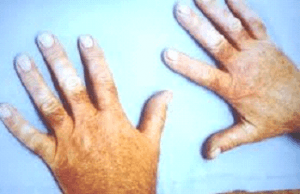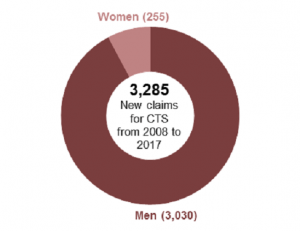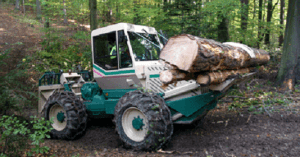Vibration – What you should know.
“Hand arm vibration breaches are up a third on construction sites”.
I read a report last week that shows that the number of hand arm vibration breaches on British construction sites has risen by third in the last year.
The figures from this report show 33% year-on-year rise in the number of reported incidents, based on more than 42,000 independent site inspections between 2017 and 2018.
Hand-arm vibration comes from the use of hand-held power tools, which can affect the nerves and joints.
So, this week, I thought I should cover the topic of Vibration – how it can harm your health, the legal aspects and how you can prevent or control it.
Vibration – What you should know.
So, what are we talking about?
Vibration affects the human body either through the hands and arms – Hand Arm Vibration (HAV) or through the legs and buttocks – Whole Body Vibration (WBV).
The health effects of HAV are the more common and contact with vibration in the frequency range 40-250 Hz may cause contraction of the blood vessels exposed to the vibration, as well as secondary tissue changes to bones, nerves and the musculature. This can cause impaired sensation and eventually persistent pain. Two common conditions associated with HAV are Vibration White Finger (VWF) and Carpal Tunnel Syndrome (CTS)
VWF and vibration related carpal tunnel syndrome are both prescribed diseases for Industrial Injuries Disability Benefit. Under the Scheme there were 635 new cases of vibration white finger in 2012. The number of new cases of vibration-related carpal tunnel syndrome assessed for 2012 was 295. Both conditions have been declining over the past decade.
The Medical Research Council estimated that 150,000 people suffered from back pain attributable to riding on industrial vehicles. However, a large number of industrial vehicle users are also involved in prolonged sitting, as well as lifting operations, which may exacerbate the effect of whole body vibration.
So what are the health effects of vibration?
Vibration is not usually a significant health problem unless it is a regular part of the work experience. However, there are a number of medical conditions (such as Raynaud’s disease), which may render workers more susceptible to injury from vibration. Also, the effect of vibration may be exacerbated by working in a cold environment.
Hand Arm Vibration (HAV)
HAV is vibration transmitted from the work equipment or process into workers’ hands and arms. It can be caused by operating hand-held power tools or hand-guided equipment. Regular and frequent exposure to high levels of vibration can lead to permanent injury. The largest successful civil claim against an employer was in respect of HAV experienced by British coal miners.
Identifying the early signs of HAV is crucial for an employer to take action to prevent the health effects becoming more serious. Regular exposure to HAV can lead to permanent injuries such as:
- damage to the blood circulation in the fingers (vibration white finger)
- pain in the wrists (Carpal Tunnel Syndrome)
- pain or loss of sensation in the hands or fingers
- loss of grip strength
- tingling sensations (pins and needles)
- loss of manual dexterity
- loss of sense of temperature in the fingers.
Vibration White Finger
Vibration White Finger (VWF) is a condition which begins with the tips of the fingers blanching (turning white) and feeling numb. As the condition progresses the whole finger may be affected. Attacks are short-lived (usually up to 30 minutes) and often end with a painful throbbing as the blood returns to the finger, normally characterised by a reddening of the finger. Approximately 40% of those reporting VWF in a self-reported work-related illness survey also reported work-related deafness or other ear problems, reflecting the fact that work which exposes people to HAV is often noisy as well.
Carpal Tunnel Syndrome

Carpal Tunnel Syndrome (CTS) is a specific type of nerve/muscle damage caused (among other things) by vibration in which the nerves in the wrist are compressed, leading to pain and stiffness. Any part of the hand could potentially be affected by numbness, tingling, loss of strength and sensitivity.
The severity of symptoms is usually graded on the Stockholm Workshop Scale, and despite its limitations, this is the recommended means of grading the severity of HAV symptoms. It separates symptoms into two independent components:
- circulatory or vascular
- sensory or sensori-neural.
The vascular component is graded from Stage 0 (no symptoms) to Stage 4 (very severe symptoms), and the sensori-neural component from Stage 0 (no symptoms) to Stage 3 (very severe symptoms).
The British Occupational Health Research Foundation (BOHRF) says there is some evidence showing the risk to be insignificant at exposure below 1m/s2. However, exposure at the new limit and action levels may still result in some individuals developing HAV syndrome, or in the deterioration of HAV symptoms where they already exist. Exposure should therefore be reduced as low as reasonably practicable. Health surveillance has a vital role to play in monitoring the effectiveness of exposure levels.
After reducing or ceasing exposure, vascular symptoms reduce in some people over a period of years. BOHRF has indicated that there is some evidence that smoking impedes recovery.
Which jobs and industries are most likely to involve hand-arm vibration?
Jobs requiring regular and frequent use of vibrating tools and equipment and handling of vibrating materials are found in a wide range of industries, for example:
- building and maintenance of roads and railways
- construction
- estate management (eg maintenance of grounds, parks, water courses, road and rail side verges)
- forestry
- foundries
- heavy engineering
- manufacturing concrete products
- mines and quarries
- motor vehicle manufacture and repair
- public utilities (eg water, gas, electricity, telecommunications)
- shipbuilding and repair
What kinds of tools and equipment can cause ill health from vibration?
There are hundreds of different types of hand-held power tools and equipment which can cause ill health from vibration. Some of the more common ones are:
- chainsaws
- concrete breakers/road breakers
- cut-off saws (for stone etc)
- hammer drills
- hand-held grinders
- impact wrenches
- Jigsaws
- needle scalers
- pedestal grinders
- polishers
- power hammers and chisels
- powered lawn mowers
- powered sanders
- scabblers
- strimmers/brush cutters
Whole Body Vibration (WBV)

Whole Body Vibration (WBV) is experienced when vibration from a vehicle or machine a person is sitting or standing on is transmitted to the torso via the buttocks or the feet.
The most common complaint from WBV is persistent back pain. This back pain is caused by degeneration in the spinal vertebra or degeneration of the discs causing compression and pain. The lower back muscles can also become weakened, increasing the risk of injury through twisting or manual handling. It may also cause:
- digestive disorders
- cardiovascular stress
- dizziness or motion sickness, due to balance organ or sensory system disorder.
Sources of WBV
There are a number of possible sources of WBV in the workplace:
- driving off-road too fast or over a rough route
- driving vehicles with poor suspension
- poor driving position – incorrect seat or control settings
- poor design of controls, making them difficult to operate
- poor driver visibility – making twisting and stretching necessary whilst driving
- other work activities – handling and lifting heavy objects
- personal factors – general fitness, age, weight etc.
Work activities of greatest risk for WBV include the use of:
- agricultural and forestry vehicles and machinery, for example tractors etc
- compaction, hammering or punching machinery – hammer drills, mobile crushers etc
- construction and quarrying vehicles and machinery – diggers, dumper trucks etc
- haulage vehicles – road, rail, buses etc
- industrial trucks – forklifts, straddle carriers etc.
So what are the Legal Requirements?
The Control of Vibration at Work Regulations 2005 Regulations.
Under the Regulations, employers are required to:
- assess the vibration risk to employees
- decide if they are likely to be exposed above the daily exposure action value (EAV) and if they are, the employer must:
- introduce a programme of controls to eliminate risk, or reduce exposure to as low a level as is reasonably practicable
- provide health surveillance (regular health checks) to those employees who continue to be regularly exposed above the action value or otherwise continue to be at risk
- decide if they are likely to be exposed above the daily exposure limit value (ELV) and if they are – take immediate action to reduce their exposure below the limit value
- provide information and training to employees on health risks and the actions the employer is taking to control those risks
- consult trade union safety representatives or employee representatives on proposals to control risk and to provide health surveillance
- keep a record of the risk assessment and control actions
- keep health records for employees under health surveillance
- review and update the risk assessment regularly.
Hand Arm Vibration Syndrome and Carpal Tunnel Syndrome are reportable conditions under the Reporting of Injuries, Diseases and Dangerous Occurrences Regulations 2013 (RIDDOR).
How you can prevent or control it.
Vibration Risk Assessment
The Regulations require employers to carry out a risk assessment in terms of employees’ exposure to vibration in the workplace. The same principles follow for carrying out a risk assessment for both Hand Arm Vibration, and Whole Body Vibration.
Firstly, the employer should:
- speak to employees and supervisors to ascertain which equipment or processes involve regular exposure to vibration
- check associated literature which accompanies machinery (handbooks etc) to see if any vibration warnings are included
- explain the symptoms of exposure to vibration and ask employees if anyone is suffering from them.
In speaking to employees and supervisors it is useful to incorporate any employee representatives/trade union safety representatives into the discussions at an early stage
Although the initial stages of the vibration risk assessment may be relatively informal and discussion-based, the person carrying out the risk assessment should have a sound knowledge of the work processes and equipment in use in the business. They will need to determine if vibration exposures are likely to be above the EAV or the ELV and to do this, the vibration impact from all relevant machinery/processes will need to be assessed as accurately as is reasonably practicable. This may be done through obtaining information from manufacturers’ handbooks, although generally this data relies on certain “standard” conditions, which may not be realistic for the workplace. On the other hand, vibration measurements can be obtained for the businesses own tools and equipment by employing a competent person using specialist equipment.
Once information regarding the vibration risk from machinery/processes is obtained it follows that the employees’ exposure to the various machinery/processes must be assessed as part of the risk assessment process. It may be useful to group employees according to whether they are high, medium or low risk vibration exposure.
High Risk (above the ELV) – this would generally consist of employees who are likely to be above the exposure limit set out in the Regulations. Examples include those who regularly operate machinery such as hammer action tools for more than about one hour per day; or some rotary and other action tools for more than about four hours per day.
Medium Risk (above the EAV) – this would generally consist of employees who are likely to be exposed above the exposure action value set down in the Regulations. Examples may include employees who regularly operate hammer action tools for more than around 15 minutes per day, or some rotary and other action tools for more than about an hour per day.
Controlling the Risk
Once the vibration risks have been assessed the next step in the risk assessment process is to put measures in place to control the risks as far as is reasonably practicable. The highest risk work tasks should be dealt with first, with the medium and lower risk activities following after this. The exact controls to be implemented will depend on the situation concerned, and each situation should be assessed on its own individual circumstances. Examples of controls can include looking at:
- introduce alternative work methods
- change work methods so that vibration risk is eliminated or reduced
- mechanise or automate the work
- equipment selection
- choose work equipment that is fit-for-purpose and can carry out the task efficiently. Equipment that is unsuitable, ill-fitting or lacking in power is likely to take much longer to complete the task and as a result it may expose employees for longer than is necessary
- choose the lowest vibration tool necessary to do the work efficiently
- limit the use of high-vibration tools wherever possible
- establish a purchasing policy for replacing old equipment and tools with ones that are suitable for the work, efficient and of lower vibration
- optimal workstation design
- enhance the design of workstations to ensure good posture and to minimise loads on employees’ hands, wrists and arms
- make use of implements such as jigs and suspension systems to reduce the load on the operator’s arms and the tightness of grip they need to apply
- maintenance
- follow an appropriate maintenance programme in line with the manufacturer’s guidelines for equipment to help prevent additional vibration
- do not use blunt or damaged concrete breaker and chipping hammer chisels and replace consumable items such as grinding wheels, so that equipment is efficient and keeps employee exposure as short as possible
- work schedules
- limit the time employees are exposed to vibration
- plan work to avoid individuals being exposed to vibration for long, continuous periods – a number of shorter periods is preferable
- where tools require continual or frequent use, introduce a rota system in order to limit exposure times
- clothing
- provide personal protective clothing to employees, particularly gloves and other items to keep them warm and dry, and hence provide further protection from the effects of vibration.
- Controls put in place must be regularly reviewed, and documented.
Health Surveillance
Health surveillance, as required under Regulation 7 of the Regulations, must be carried out for employees exposed to vibration above the Exposure Action Value in the workplace. In its basic sense health surveillance consists of regularly seeking information about early symptoms of ill health using a questionnaire – this can be done in-house, or through the use of an external occupational health service.
If any problems are detected in the initial stages of health surveillance, the individual concerned should be referred on to an occupational health practitioner or doctor. Ultimately an occupational health doctor will be required for a clinical diagnosis.
Under Regulation 7 an employer is required to:
- keep records of the health surveillance and fitness-for-work advice provided for each employee (not confidential records, however, which are kept by the doctor)
- make these records available to the employees
- act upon any recommendations made by the doctor about employees’ continued exposure to vibration
- use the results to review and where necessary revise the vibration risk assessment, including plans to control the risks
- discuss any changes to the vibration risk assessment with the trade union safety representative or representative of employee safety
- notify the relevant enforcing authority when advised in writing by a doctor that an employee whose work involves regular use of percussive or vibrating tools has Hand Arm Vibration Syndrome or Carpal Tunnel Syndrome, as required by the Reporting of Injuries, Diseases and Dangerous Occurrences Regulations 2013 (RIDDOR).
Information, Instruction and Training
Information and Training in terms of vibration at work is required under Regulation 8 of the Regulations. An employer should provide employees with information on the following points:
- the health effects of vibration, and how to recognise and report symptoms
- sources of vibration
- to which level they are at risk (eg above the ELV – high risk, or above the EAV – medium risk)
- risk factors (eg the levels of vibration, daily exposure duration, regularity of exposure over weeks, months, years)
- the need for health surveillance, how it can help them remain fit for work, how health surveillance will be provided, how the results will be used, and the confidentiality of results
- ways to minimise risk, such as:
- changes to working practices to reduce exposure to vibration
- correct selection, use and maintenance of equipment
- correct techniques for equipment use, how to reduce grip force etc
- maintenance of good blood circulation at work by keeping warm and massaging fingers and, if possible, no smoking.
If you would like any further help or support, please please contact us by phone 01458 253682, email or via our Facebook page or by Twitter.
Taunton & Somerset CPD Group at The Exchange House Taunton
Please remember that we now run these CPD events at the Exchange House, 12 – 14 The Crescent, Taunton TA1 4EB on a fortnightly basis
The next of the CPD events is listed below.
As previously requested, if you could let us know whether or not you can attend it would be greatly appreciated. Also, if you would like to give a talk, or know of somebody who would, please contact Jon at [email protected]
Our next Seminar will be on Wednesday 13th March 2019. Could you please arrive by 12:30pm prompt.
Our speaker for this one is Ian Dryden of SIG Design & Technology will talk about Roof Refurbishment
If you haven’t already booked your place, or if you are not on the CPD Seminar mailing list but would like to be please drop Jon an email and he will deal with your request.
As per our last one if you could let Jon know whether or not you can attend within 7 days of receipt of his email, it would be greatly appreciated.
Contact Details [email protected], 07831 714199 or 01458 253682
*Early notice of 27th March meeting. Jeremy Miles of Geogrow will talk about Vegetated Retaining Wall Systems
For more details about these and the other forthcoming CPD talks please see cpds to 24th April 2019.
Training Courses
We shall be running more new courses throughout 2019 and the dates and details of forthcoming courses will be published here each week.
But remember we are still available for running “In House” courses and are looking to add new training courses to our list.
If you have any questions about these courses or any other training or would like us to run a particular course for you, call Jon Wilkins of the Wilkins Safety Group on 01458 253682 or email him at [email protected]
Roller coaster derailment injures nine passengers
Operator of M & D’s theme park sentenced after roller coaster derailment injures nine passengers
A theme park operator has today been fined after nine passengers were injured and taken to hospital when a train on one of their roller coasters derailed and crashed to the ground.
Hamilton Sheriff Court heard how, on 26 June 2016, at M & D’s Theme Park in Motherwell, a train on the Tsunami roller coaster, which was carrying nine passengers at the time, derailed as it was descending through a curve immediately after the lift ramp, at a height of 5 metres, and crashed to the ground in an area occupied by mini self-drive cars and bikes.
An investigation by the Health and Safety Executive (HSE) found the Tsunami roller coaster was not maintained in an efficient state, in efficient working order nor was it in good repair, and that in particular, weld repairs carried out on the axels of the Tsunami were inadequate and unsound.
M & D (Leisure) Limited, Strathclyde Country Park, Hamilton Road, Motherwell pleaded guilty to breaching Regulation 5(1) of the Provision and Use of Work Equipment Regulations 1998 and has been fined £65,000.
Speaking after the hearing, HSE inspector Martin McMahon said:
“This was a serious incident that resulted in members of the public being badly injured while they were supposed to be enjoying themselves. Our investigation found the company failed to ensure the Tsunami roller coaster was properly maintained and the result of these poor maintenance procedures led directly to its catastrophic failure on 26 June 2016.
“It is imperative that all controllers of fairground rides have thorough maintenance procedures in place to ensure that the public are safe when they are enjoying the thrills at a fair or theme park.”
Worker severely-injured by bench drill
Foundry prosecuted after worker severely-injured by bench drill
A Norfolk-based foundry has been fined after a part-time machinist suffered life-changing injuries whilst drilling holes into aluminium castings.
Norwich Crown Court heard how, on 13 February 2017, the worker was working at Moore’s Industrial Estate in Stalham wearing heavy duty gloves as specified by company policy, when her hand came into contact with a moving drill bit. The worker’s hand became entangled with the machinery resulting in severe tendon injuries, and the partial de-gloving and severing of the left thumb.
An investigation by the Health and Safety Executive (HSE) found Edward Flitton, trading as Hever Ironworks, had neither a safe system of work in place for employees using the drilling and tapping machines, nor Employers Compulsory Liability Insurance at the time of the incident. In addition, the incident was not reported to HSE by Edward Flitton but brought to HSE’s attention in September 2017 by a third party.
Edward Flitton of Moores Yard, Stalham, pleaded guilty to breaching Section 2(1) of the Health and Safety at Work Act 1974, Regulation 4(1)(b) of the Reporting of Injuries, Disease and Dangerous Occurrences Regulations 1995 and breaching Regulation 1(1) of the Employers’ Liability (Compulsory Insurance) Regulations 1998. Mr Flitton has been sentenced to a community order of 120 hours of unpaid work and fined £300.
Speaking after the hearing, HSE inspector Ivan Brooke said:
“This incident could so easily have been avoided by implementing appropriate control measures and safe working practices.
“Companies should be aware that HSE will not hesitate to take appropriate enforcement action against those that fall below the required standards”.
Remember
Unlike other organisations who send out newsletters giving you a little titbit of information, then stating that if you want to follow the full link or read the full story or get more information you must pay to subscribe to their service.
- Our newsletter service is FREE,
- The links we supply are FREE,
- The helpline advice is FREE.

If you find this newsletter service of use and you think others might also find it useful, then kindly pass it on and ask them to subscribe for free, so they can continue to receive it in their own right.
Also contact us if you have a particular health and safety subject or question you would like covered
If you have any queries on any health and safety matter, please contact Jon Wilkins on 01458 253682 or by email on [email protected]



